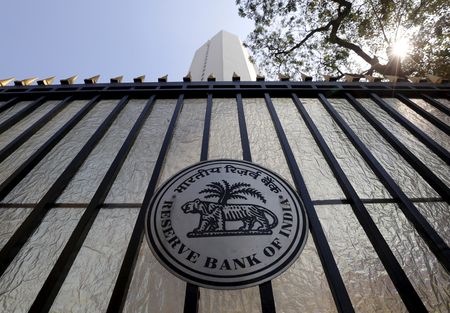By Bharath Rajeswaran
(Reuters) -Indian benchmark indexes fell on Friday as a widely expected interest rate cut failed to excite investors who were expecting more measures from the central bank to boost liquidity.
The Nifty 50 fell 0.18% to close at 23,559.95, while the BSE Sensex shed 0.25% to 77,860.19. Financial stocks were the biggest losers.
For the week, however, the benchmarks gained 0.33% and 0.46%, respectively.
The Reserve Bank of India (RBI) lowered the repo rate by 25 basis points to 6.25% to reignite economic growth.
Some investors had expected the RBI to cut banks’ cash reserve ratio (CRR) – the proportion of deposits that banks need to set aside with the central bank as cash – a move that would have helped banks issue more loans and enhance their liquidity.
The RBI’s commitment to ensure sufficient but not surplus liquidity has left markets slightly disappointed, said Unmesh Kulkarni, managing director and senior advisor at Julius Baer India.
A neutral policy stance and lack of specific announcements to boost liquidity imply that the central bank may opt for only one or two rate reductions in 2025 amounting to 25 bps-50 bps compared with earlier expectations of three to four rate cuts of 75 bps-100 bps cumulatively, according to multiple analysts.
Financials fell 0.5%, while state-owned banks dropped about 1.4%.
“Banks and financials should brace for some margin compression due to a shallow rate cut cycle,” said Macquarie analyst Suresh Ganapathy.
Top private lender HDFC Bank lost 0.6%, while Reliance and ICICI Bank fell about 1.2% each. The three stocks top the Nifty 50 index in terms of weightage.
While easing rates could help boost consumption and economic growth, they are also “expected to widen the gap between U.S. and Indian bond yields, potentially accelerating capital outflows from India and hurting the currency,” said Umeshkumar Mehta, chief investment officer at Samco Mutual Fund.
The rupee has sunk to record lows and posted its worst week in over two years, on the back of a stronger dollar and persistent foreign portfolio outflows.[INR/]
(Reporting by Bharath Rajeswaran in Bengaluru; Editing by Savio D’Souza and Saumyadeb Chakrabarty)










